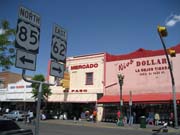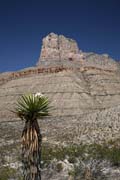Located in the sparsely populated plains of the Chihuahuan
Desert on the border of Texas and New Mexico, the Guadalupe
Mountains are one of the finest examples of an ancient marine
fossil reef on Earth. The story of Guadalupe and Carlsbad Caverns
begins 250 million years ago with the creation of a 400-mile-long
reef in an inland sea that covered the region. Eventually the sea
evaporated, and the reef was buried under deposits of salts and
gypsum. Then a few million years ago, uplift and erosion began to
uncover the buried rock reef, and became the Guadalupe Mountains.
At the same time, hydrogen sulfide-rich water dissolved the
limestone and opened up the fractures and faults into large
chambers as we see today.
Getting there ...
We had an early flight to El Paso, Texas, with one stop at Los
Angels. The flight was on time and smooth, and the only surprise
was when the captain announced the weather forecast in El Paso
was only 35F, which was about 30 degrees lower than what we
checked 2 days ago.
- Winter was still around??
When we left El Paso, we were warned by Border Patrol
that there was snow in the region. When we approached the
Guadalupe Mountains, the desert was all covered by fresh
snow. We were all in awe in seeing such a sight in the
desert's spring time. We passed by Guadalupe and Carlsbad
National Parks before checked in the hotel in Whites
City.
The Second Day (Carlsbad Cavern National Park) ...
- Big Room
The Natural Entrance Trail was still too icy and slippery
to open, so we had to take the elevator down to the cave
directly from the visitor center. The cave temperature is
56F year around, and it's much warmer than the outdoors
above the ground at this time.
The decoration of Carlsbad Cavern with stalacties,
stalagmites, and an incredible variety of other
formations began more than 500,000 years ago after much
of the cavern had been cut out. It happened slowly --
drop by drop. The basic tour through Carlsbad Cavern is
the Big Room Route, a one-mile, self-guiding, underground
stroll around the perimeter of the largest room in the
cave, the Big Room. Taking approximately one hour (in our
case, we spent almost 2 hours with a much slower pace
because I stopped often to take quite a few long exposure pictures),
this circular route passes many large and famous features
including Bottomless Pit, Giant Dome, Rock of Ages and
Painted Grotto. Highly decorated and immense, the 8.2
acre Big Room is a "must see" tour for all
visitors to the park.
- King's Palace
After lunch at the lunchroom in the cave, we joined the
King's Palace guided tour (which I reserved one day
earlier). This 1.5-hour ranger-guided tour descends to
the deepest portion of the cavern with paved trails, 830
feet beneath the desert surface. Besides those amazing
formations, the highlight of the tour was a few minutes
of black out: briefly turning off all artificial lights
to reveal the permanent inky blackness of the natural
cave environment.
The Third Day (Guadalupe) ...
- I got up early for the sunrise, but I gave up after
stepping into the car. The weather was so poor that it
was foggy and drizzling. After breakfast, we went back to
Carlsbad to try the Natural Entrance Trail again, but it
was still closed due to the slippery condition.
.
- Devil's Hall
We got some sandwiches and salads, and headed to
Guadalupe National Park for some more serious hiking. The
weather had cleared up, and the temperature was back to
the "normal" spring time ~ 70F. The Devil's
Hall trail is rated as "Moderate, level but very
rocky", which is Linus' favorite style. The trail
route is 4.2-mile round trip and is marked by rock cairns
along the canyon floor. We climbed the Hikers Staircase
of natural rocks to the Devil's Hall in Pine Springs
Canyon. Linus and Iris were so excited on this trail that
they often climbed up and down on the rocks along the
trail and still kept up with us.
The Fourth Day (Carlsbad + Guadalupe) ...
- Sunrise at Guadalupe
Finally the sky was clear for a nice sunrise. I drove to
a rest area outside the Guadalupe National Park entrance,
and waited in the car because it was so windy that I
could not stay too long outside.
- Natural Entrance, Carlsbad
We went back to Carlsbad and took the Natural Entrance
trail into the cave. More than 1,000 years ago,
prehistoric Indians ventured into the entrance of
Carlsbad Cavern, and left mysterious drawings one the
cave walls near the natural entrance. In the late 1800s,
a young cowboy named Jim White was drawn by the spectacle
of hundreds of thousands of bats rising up out of the
natural entrance in the evening. He was fascinated by the
cave and spent hours exploring it, and started to promote
and lead tours to the cave, and finally became the first
chief ranger when Carlsbad Cavern was proclaimed a
national monument in 1923.
The Natural Entrance trail is well worth the effort
although it is not difficult at all. Walking down the
trail toward the dark and bottomless cave was quite an
experience that no other hike can offer.
- McKittrick Canyon, Guadalupe
The 4.8-mile round-trip trail follows an intermittent
stream through the desert, transition, and canyon
woodlands to the historic Pratt Lodge. McKittrick Canyon
is a confluence of diversity. Trees of the east, north,
and west, the grasses of the plains, and the cactus and
succulents of the desert join with the animal life of
both mountain and desert here in this canyon. Most famous
for its spectacular fall foliage, thousands of people
come to visit this attraction, and hike between the
canyon walls that shelter a perennial stream. This was
the windiest day during our stay. Linus and Iris liked to
take off their shirts and made them like human kites when
the wind blew. Halfway on the trail, Linus spotted a snake
on the trail that was approximately four feet long. I
felt I was lucky that I was not at the leading position
at the time. Although this trail was rated as moderate,
both Linus and Iris got bored after a while since they
thought it's not challenge enough.
The Last Day,
- Frijole Ranch, Guadalupe
We went to the Smith Springs Loop Trail in the Frijole
Ranch in the morning. The loop is a 2.3-mile easy walk
passing Manzanita Springs on the way to the shady oasis
of Smith Springs. Artifacts reveal that the Frijole area
has been a popular place of settlement for many
centuries. This is not surprising when one considers that
Pine, Juniper, Smith, Manzanita, and Frijole springs are
all within a 2 mile radius of the Frijole Ranch History
Museum.
Going Home ...
- El Paso
 |
After short lunch picnic, we
started to drive back to El Paso. The view along
hwy 180 is spectacular that we did not have a
chance to see them when we arrived because of bad
weather. When we got closer to El Paso, I was
speeding and caught by a police. Luckily, the
Texas police was quite nice and only gave me a
warning without any fine. Before headed to the
airport, we detoured to El Paso downtown and
walked around a block close to the Mexican
border. This part of city looks more like a
Mexican city than an American one. |
 |
We had totally different experiences from these two parks,
Guadalupe Mountains and Carlsbad Cavern, one above the desert
and one underground, but we were equally amazed by their
natural power and beauty. There are always excuses to come
back again in the future: evening bat flight in Carlsbad, and
the highest peak in Texas in Guadalupe.
[Back to Photo Page] [Carlsbad Gallery] [Guadalupe Gallery]